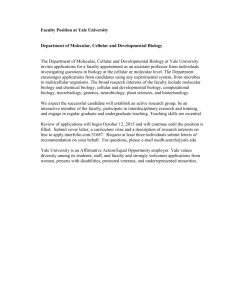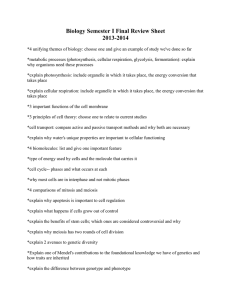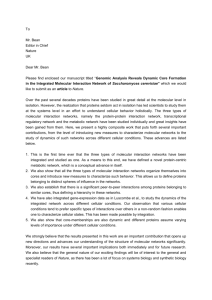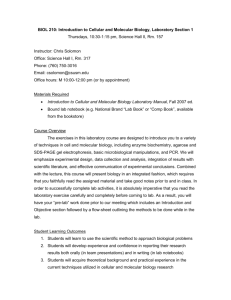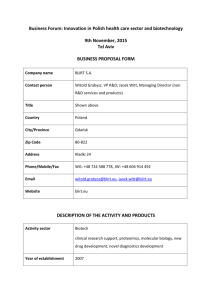Tutorial for module BY1101 Cell biology revision: MCQ Joe Colgan
advertisement
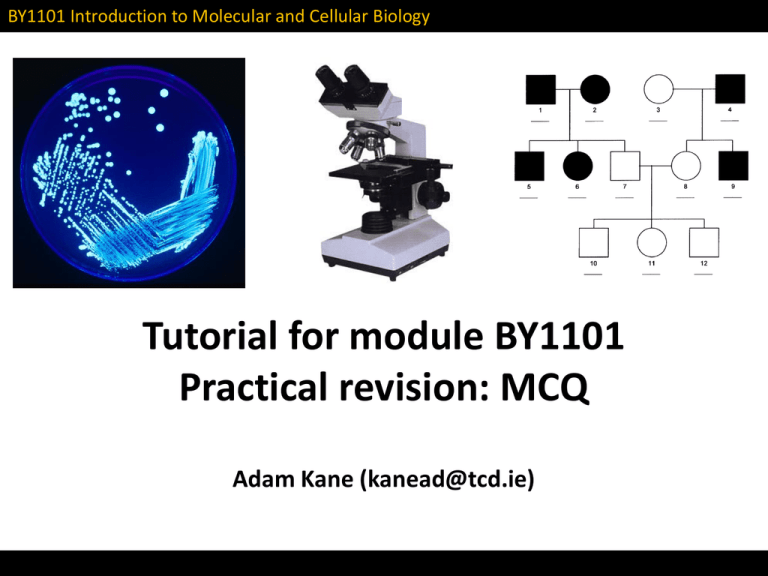
BY1101 Introduction to Molecular and Cellular Biology Tutorial for module BY1101 Practical revision: MCQ Adam Kane (kanead@tcd.ie) BY1101 Introduction to Molecular and Cellular Biology BY1101: Practical MCQ • Multiple choice questions • 20 questions (Slide will change every minute) • Self assessment Disclaimer •Tutors have not seen previous papers •We don’t know what will be on the test •Questions asked are based on information asked of you within your practical books BY1101 Introduction to Molecular and Cellular Biology Q. 1 What type of microscopy was used within your practicals? A. B. C. D. E. Electron microscopy Scanning probe microscopy Light microscopy Laser microscopy Ultraviolet microscopy BY1101 Introduction to Molecular and Cellular Biology Q. 2 What is the standard metric unit of length? A. B. C. D. E. Feet Inch Metre Yard Furlong BY1101 Introduction to Molecular and Cellular Biology Q. 3 What type of cell is displayed in the image below? A. B. C. D. E. An eukaryotic plant cell A prokaryotic bacterial cell An eukaryotic animal cell An eukaryotic bacterial cell None of the above BY1101 Introduction to Molecular and Cellular Biology Q. 4 Which term best describes the condition of plant cells when placed in a hypertonic solution? A. B. C. D. E. Haemolysis Plasmolysis Crenation Turgor pressure Osmotic pressure BY1101 Introduction to Molecular and Cellular Biology Q. 5 Within your practical, which of the following solutions caused the plant cells to undergo plasmolysis at the fastest rate? A. B. C. D. E. 0.5 M KCL (Potassium chloride) 0.8 M Sucrose 0.5 M KSCN (Potassium thiocyanate) 0.5 M Sucrose Water BY1101 Introduction to Molecular and Cellular Biology Q. 6 Within your practical, how many stages of plasmolysis were distinguishable in the onion epidermal cells? A. B. C. D. E. Three Five Six Two Stages are indistinguishable in onion epidermal cells BY1101 Introduction to Molecular and Cellular Biology Q. 7 Within the image below, what type of cell is indicated by the arrow? A. B. C. D. E. Erythrocyte Monocyte Lymphocyte Neutrophil Platelet BY1101 Introduction to Molecular and Cellular Biology Q. 8 If you look at Penicillium inoculates under a microscope you will see the following structure. What structure of Penicillium is labelled in the image below? A. B. C. D. E. Conidia Spore Phialides Hypha Conidiophore BY1101 Introduction to Molecular and Cellular Biology Q. 9 Plant cell protoplasts are shown in the image below. “Protoplasts” refer to cells that are missing what component of the normal plant cell? A. B. C. D. E. Mitochondria Nucleus Central vacuole Chloroplast Cell wall BY1101 Introduction to Molecular and Cellular Biology Q. 10 What stage of mitosis is demonstrated in the image below? A. B. C. D. E. Interphase Prophase Metaphase Anaphase Telophase BY1101 Introduction to Molecular and Cellular Biology Q. 11 What stage of mitosis is demonstrated in the image below? A. B. C. D. E. Interphase Prophase Metaphase Anaphase Telophase BY1101 Introduction to Molecular and Cellular Biology Q. 12 From a height distribution study performed within the junior freshman class, which is the most common height for females? 176-180cm 166-170cm 181-185cm 151-155cm 161-165cm Height Distribution (by sex - 2009/10) 30 25 20 Frequency A. B. C. D. E. Males Females 15 10 5 0 151155 156160 161165 166170 171175 176180 Height (cm) 181185 186190 191195 196200 BY1101 Introduction to Molecular and Cellular Biology Q. 13 Five students had their height measured with the following results: Student A (172cm); Student B (180cm); Student C (158cm); Student D (166cm); Student E (170cm). What is the mean height demonstrated amongst these five students? A. B. C. D. E. 180cm 169.2cm 161.8cm 173.4cm 155cm BY1101 Introduction to Molecular and Cellular Biology Q. 14 Examine the following pedigree, within which the existence of an individual with a particular hereditary trait is indicated by a shaded symbol. What type of pedigree and allele is most likely to cause this trait? A. B. C. D. E. Autosomal dominant Sex-linked dominant Sex-linked recessive Autosomal recessive None of the above BY1101 Introduction to Molecular and Cellular Biology Q. 15 Examine the following pedigree, within which the existence of an individual with a particular hereditary trait is indicated by a shaded symbol. What type of pedigree and allele is most likely to cause this trait? A. B. C. D. E. Autosomal dominant Sex-linked dominant Sex-linked recessive Autosomal recessive None of the above BY1101 Introduction to Molecular and Cellular Biology Q. 16 Examine the following pedigree, within which the existence of an individual with a particular hereditary trait is indicated by a shaded symbol. What type of pedigree and allele is most likely to cause this trait? A. B. C. D. E. Autosomal dominant Sex-linked dominant Sex-linked recessive Autosomal recessive None of the above BY1101 Introduction to Molecular and Cellular Biology Q. 17 What type of technique is used to transfer inoculates from a microbial colony to achieve a pure colony? A. B. C. D. E. Passive Efficacious Cytolytic Aseptic Active BY1101 Introduction to Molecular and Cellular Biology Q. 18 Staphylococcus aureus is a gram positive bacteria. When gram stained, what colour will S. aureus be stained? A. B. C. D. E. Pink Purple White Green Black BY1101 Introduction to Molecular and Cellular Biology Q. 19 S. aureus, a common pathogenic organism of humans, releases a membranedamaging cytolytic agent, β-lysin, that results in ______. A. B. C. D. E. Plasmolysis Haemolysis Apoptosis Cell growth Bacteriastatic effects BY1101 Introduction to Molecular and Cellular Biology Q. 20 A susceptible strain of S. aureus is growing on an Agar plate. You treat the plate with an antibiotic pellet. What do you expect to happen on the plate? A. B. C. D. E. The bacteria culture is unaffected by the antibiotic The entire culture is killed by the effects of the antibiotic A zone of inhibition will develop around the antibiotic pellet The bacteria will evolve resistance Incubation of the plate at 37°C reduces the effects of the antibiotic BY1101 Introduction to Molecular and Cellular Biology Time is up • Pass your answers to your neighbour and we will correct BY1101 Introduction to Molecular and Cellular Biology Q. 1 What type of microscopy was used within your practicals? A. B. C. D. E. Electron microscopy Scanning probe microscopy Light microscopy Laser microscopy Ultraviolet microscopy BY1101 Introduction to Molecular and Cellular Biology Q.2 What is the standard metric unit of length? A. B. C. D. E. Feet Inch Metre Yard Furlong BY1101 Introduction to Molecular and Cellular Biology Q. 3 What type of cell is displayed in the image below? A. B. C. D. E. An eukaryotic plant cell A prokaryotic bacterial cell An eukaryotic animal cell An eukaryotic bacterial cell None of the above BY1101 Introduction to Molecular and Cellular Biology Q. 4 Which term best describes the condition of plant cells when placed in a hypertonic solution? A. B. C. D. E. Haemolysis Plasmolysis Crenation Turgor pressure Osmotic pressure BY1101 Introduction to Molecular and Cellular Biology Q. 5 Within your practical, which of the following solutions caused the plant cells to undergo plasmolysis at the fastest rate? A. B. C. D. E. 0.5 M KCL (Potassium chloride) 0.8 M Sucrose 0.5 M KSCN (Potassium thiocyanate) 0.5 M Sucrose Water BY1101 Introduction to Molecular and Cellular Biology Q.6 Within your practical, how many stages of plasmolysis were distinguishable in the onion epidermal cells? A. B. C. D. E. Three Five Six Two Stages are indistinguishable in onion epidermal cells BY1101 Introduction to Molecular and Cellular Biology Q. 7 Within the image below, what type of cell is indicated by the arrow? A. B. C. D. E. Erythocyte Monocyte Lymphocyte Neutrophil Platelet Lymphocyte Monocyte BY1101 Introduction to Molecular and Cellular Biology Q. 8 If you look at Penicillium inoculates under a microscope you will see the following structure. What structure of Penicillium is labelled in the image below? A. B. C. D. E. Conidia Spore Phialides Hypha Conidiophore BY1101 Introduction to Molecular and Cellular Biology Q. 9 Plant cell protoplasts are shown in the image below. “Protoplasts” refer to cells that are missing what component of the normal plant cell? A. B. C. D. E. Mitochondria Nucleus Central vacuole Chloroplast Cell wall BY1101 Introduction to Molecular and Cellular Biology Q. 10 What stage of mitosis is demonstrated in the image below? A. B. C. D. E. Interphase Prophase Metaphase Anaphase Telophase Interphase Prophase Metaphase Anaphase Telophase BY1101 Introduction to Molecular and Cellular Biology Q. 11 What stage of mitosis is demonstrated in the image below? A. B. C. D. E. Interphase Prophase Metaphase Anaphase Telophase Interphase Prophase Metaphase Anaphase Telophase BY1101 Introduction to Molecular and Cellular Biology Q. 12 From a height distribution study performed within the junior freshman class, which is the most common height for females? 176-180cm 166-170cm 181-185cm 151-155cm 161-165cm Height Distribution (by sex - 2009/10) 30 25 20 Frequency A. B. C. D. E. Males Females 15 10 5 0 151155 156160 161165 166170 171175 176180 Height (cm) 181185 186190 191195 196200 BY1101 Introduction to Molecular and Cellular Biology Q. 13 Five students had their height measured with the following results: Student A (172cm); Student B (180cm); Student C (158cm); Student D (166cm); Student E (170cm). What is the mean height demonstrated amongst these five students? A. B. C. D. E. 180cm 169.2cm 161.8cm 173.4cm 155cm BY1101 Introduction to Molecular and Cellular Biology Q. 14 Examine the following pedigree, within which the existence of an individual with a particular hereditary trait is indicated by a shaded symbol. What type of pedigree and allele is most likely to cause this trait? A. B. C. D. E. Autosomal dominant Sex-linked dominant Sex-linked recessive Autosomal recessive None of the above Three genotypes aa aa aa Aa Aa AA Aa Aa Aa aa Aa aa aa Aa aa aa aa Aa Homozygous dominant (AA) Aa Heterozygous (Aa) Homozygous recessive (aa) BY1101 Introduction to Molecular and Cellular Biology Q. 15 Examine the following pedigree, within which the existence of an individual with a particular hereditary trait is indicated by a shaded symbol. What type of pedigree and allele is most likely to cause this trait? A. B. C. D. E. Autosomal dominant Sex-linked dominant Sex-linked recessive Autosomal recessive None of the above Aa aa Aa Aa Three genotypes Homozygous dominant (AA) Aa Aa aa aa Aa Heterozygous (Aa) aa aa aa Homozygous recessive (aa) BY1101 Introduction to Molecular and Cellular Biology Q. 16 Examine the following pedigree, within which the existence of an individual with a particular hereditary trait is indicated by a shaded symbol. What type of pedigree and allele is most likely to cause this trait? A. B. C. D. E. Autosomal dominant Sex-linked dominant Sex-linked recessive Autosomal recessive None of the above xx X-linked genotypes XY X-linked recessive (xx/xY) XY xX xY xY xX XY xX xX xY xY xx xx X-linked dominant (xX/XY) xY BY1101 Introduction to Molecular and Cellular Biology Q. 17 What type of technique is used to transfer inoculates from a colony to achieve a pure colony? A. B. C. D. E. Passive Efficacious Cytolytic Aseptic Active BY1101 Introduction to Molecular and Cellular Biology Q. 18 Staphylococcus aureus is a gram positive bacteria. When gram stained, what colour will S. aureus be stained? A. B. C. D. E. Pink Purple White Green Black BY1101 Introduction to Molecular and Cellular Biology Q. 19 S. aureus, a common pathogenic organism of humans, releases a membranedamaging cytolytic agent, β-lysin, that results in ______. A. B. C. D. E. Plasmolysis Haemolysis Apoptosis Cell growth Bacteriastatic effects BY1101 Introduction to Molecular and Cellular Biology Q. 20 A susceptible strain of S. aureus is growing on an Agar plate. You treat the plate with an antibiotic pellet. What do you expect to happen on the plate? A. B. C. D. E. The bacteria culture is unaffected by the antibiotic The entire culture is killed by the effects of the antibiotic A zone of inhibition will develop around the antibiotic pellet The bacteria will evolve resistance Incubation of the plate at 37°C reduces the effects of the antibiotic BY1101 Introduction to Molecular and Cellular Biology How did you do? BY1101 Introduction to Molecular and Cellular Biology Link for studying pedigrees https://www.youtube.com /watch?v=-Ztzi6pAh5M BY1101 Introduction to Molecular and Cellular Biology For the exam: Read over the practical book (all aspects) Exam is worth ~22% of BY1101 module 45 minutes – 30 questions (1 question every 90 secs) Exam is non-negative marking so attempt all questions BY1101 Introduction to Molecular and Cellular Biology Tutorials will return in the New Year Check your emails Otherwise, have a joyous Christmas and wonderful New Year
